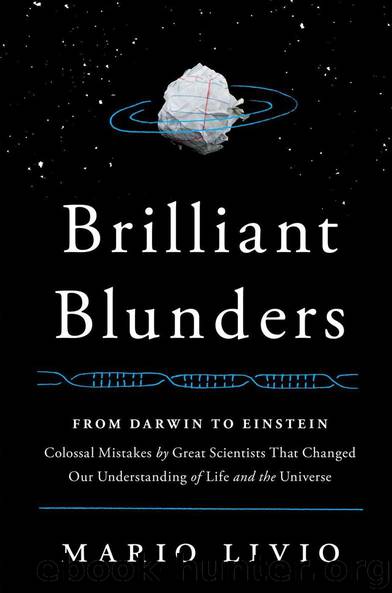Brilliant Blunders: From Darwin to Einstein - Colossal Mistakes by Great Scientists That Changed Our Understanding of Life and the Universe by Livio Mario

Author:Livio, Mario [Livio, Mario]
Language: eng
Format: epub, mobi
Publisher: Simon & Schuster
Published: 2013-05-13T22:00:00+00:00
Figure 22
There was one thing that the B2FH paper did not achieve. No matter how hard they tried, Hoyle and his collaborators did not manage to account for the abundances of the lightest elements by forming them inside stars. Deuterium, lithium, beryllium, and boron were just too fragile—the heat in stellar interiors was sufficient for these elements to be destroyed by nuclear reactions, rather than created. Helium, the second most abundant element in the cosmos, proved to be problematic too. This may sound surprising, since stars are clearly forming helium. After all, isn’t the fusion of four hydrogens into helium the main source of power for most Sun-like stars? The difficulty turned out to be not at all with synthesizing helium in general, but with synthesizing enough of it. Detailed calculations have shown that nucleosynthesis in stars would predict for helium a cosmic abundance of only about 1 percent to 4 percent, while the observed value is about 24 percent. This left the big bang as the lone source for the lightest elements, just as Gamow and Alpher had suggested.
You may have noticed that the story of the genesis of the elements—the “history of matter,” as Hoyle called it—contains in it some sort of “cosmic compromise.” Gamow wanted all the elements to have been created within a few minutes following the big bang (“in less time than it takes to cook a dish of duck and roast potatoes”). Hoyle wanted all the elements to be forged inside stars during the long process of stellar evolution. Nature chose a give-and-take: Light elements such as deuterium, helium, and lithium were indeed synthesized in the big bang, but all the heavier elements, and in particular those essential for life, were cooked in stellar interiors.
Hoyle got a chance to present his version of the history of matter even at the Vatican. Just a few months before the B2FH paper appeared in print, the Pontifical Academy of Sciences and the Vatican Observatory organized a scientific meeting on “Stellar Populations” at the Vatican. The two dozen invitees included some of the most distinguished scientists in astronomy and astrophysics at the time. Both Fowler and Hoyle presented their results on the synthesis of the elements, and Hoyle was also asked to give a summary of the entire meeting from a physical point of view. The Dutch astronomer Jan Oort summarized from an astronomical perspective. At the opening of the meeting, on May 20, 1957, the participants met Pope Pius XII. Figure 23 shows Hoyle shaking the Pope’s hand. Willy Fowler (with his back to us) stands to Hoyle’s right, and Walter Baade (facing us) is to the Pope’s right.
The rest, as they say, is history. The experimental and theoretical program at Kellogg Lab became, under Willy Fowler’s dynamic leadership, the hub for nuclear astrophysics. Fowler went on to win the Nobel Prize in physics in 1983 (together with astrophysicist Subramanyan Chandrasekhar). Many people, including Fowler himself, felt that Hoyle should have also shared the prize. In 2008
Download
Brilliant Blunders: From Darwin to Einstein - Colossal Mistakes by Great Scientists That Changed Our Understanding of Life and the Universe by Livio Mario.mobi
This site does not store any files on its server. We only index and link to content provided by other sites. Please contact the content providers to delete copyright contents if any and email us, we'll remove relevant links or contents immediately.
Enlightenment Now: The Case for Reason, Science, Humanism, and Progress by Steven Pinker(7245)
A Journey Through Charms and Defence Against the Dark Arts (Harry Potter: A Journey Through…) by Pottermore Publishing(4783)
The Immortal Life of Henrietta Lacks by Rebecca Skloot(4530)
A Journey Through Divination and Astronomy by Publishing Pottermore(4348)
Elon Musk by Ashlee Vance(4036)
Origin Story: A Big History of Everything by David Christian(3654)
COSMOS by Carl Sagan(3561)
Alchemy and Alchemists by C. J. S. Thompson(3456)
Bad Pharma by Ben Goldacre(3365)
Enlightenment Now by Steven Pinker(3339)
Shadow of Night by Deborah Harkness(3309)
Inferior by Angela Saini(3279)
A Mind For Numbers: How to Excel at Math and Science (Even If You Flunked Algebra) by Barbara Oakley(3226)
Origin Story by David Christian(3151)
The Code Book by Simon Singh(3080)
Signature in the Cell: DNA and the Evidence for Intelligent Design by Stephen C. Meyer(3077)
The Elements by Theodore Gray(3004)
A Brief History of Time by Stephen Hawking(2964)
A Journey Through Potions and Herbology (A Journey Through…) by Pottermore Publishing(2828)
